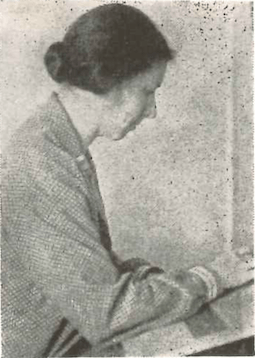Rose Connor facts for kids
Quick facts for kids
Rose Connor
|
|
|---|---|

Rose Connor in 1948
|
|
| Born | March 4, 1892 |
| Died | December 29, 1970 (aged 78) |
| Occupation | Architect |
| Years active | 1923 – 64 |
| Signature | |
Rose Connor (born March 4, 1892 – died December 29, 1970) was an American architect. She was known as one of the first and most successful women architects of her time. Most of her work involved designing homes in Southern California. She also worked on projects for the U.S. military and a place called Fuller Theological Seminary.
Contents
About Rose Connor's Life
Rose Connor was born in Des Moines, Iowa in 1892. Her parents were William Connor and Eva Gatch. Her father was a lawyer and an important person in Des Moines. He had fought in the American Civil War. He was born in Ireland and moved to the United States when he was a boy. Rose had three sisters: Elizabeth, Marjorie, and Dorothy. Her father passed away when she was a child.
Rose's Education and Learning
Rose went to public schools in Des Moines until the eleventh grade. After that, she continued her studies in other countries. She studied art and jewelry at the Académie Colarossi in Paris, France. She also attended the Birmingham School of Art in Birmingham, England.
Later, Rose returned to the U.S. and studied interior decoration. She went to the New York School of Fine and Applied Art. She also studied at Cooper Union.
Starting in 1923, Rose worked as a drafter for several architects. She worked for T. Beverly Keim in Los Angeles and Allen & Collens in Boston. She also worked for Soule & Murphy in Santa Barbara. In Los Angeles, she worked for Reginald D. Johnson, W. L. Risley, and Allison & Allison. During this time, from 1925 to 1930, she also studied architecture. She learned at the Pasadena Atelier of the Beaux-Arts Institute of Design.
Rose's Career as an Architect
Rose Connor received her license to practice architecture in California in 1936. She then opened her own company in Pasadena in October of that year. She became a member of the American Institute of Architects (AIA) in 1944. Most of her projects were designing homes for professional women. From 1946 to 1950, she also designed several small housing developments. These projects had between 16 and 74 houses. They were built in Lakewood, Downey, and Anaheim.
A very important client for Rose was Reverend Charles E. Fuller. He and his wife Grace asked Rose to design eight different houses for them. These houses were for their own use or to rent out. Rose also worked with the firm Orr, Strange & Inslee. She helped them build the Fuller Theological Seminary in 1953.
Rose stopped her work from February 1942 to April 1946. This was because of World War II. During this time, she worked for the United States Army Corps of Engineers. She worked on camouflage and other important tasks.
Rose often worked with landscape architects Florence Yoch and Lucile Council. They helped design the outdoor spaces for her projects. She also worked with another architect named John Byers. Together, they designed an adobe house in San Gabriel in 1946.
Women in Architecture
When Rose Connor started her career, there were not many women architects. Rose was only the sixth woman from California to join the AIA. In 1948, only 10 women architects in California had their own companies. This was reported by the Los Angeles Times.
That same year, a magazine called Architectural Record looked at women in architecture. They found that 1,119 women had studied architecture. However, only 108 of them were actually working as architects. The magazine featured the work of 18 women architects, including Rose Connor.
Rose was a member of the Union Internationale des Femmes Architectes (UIFA). In 1958, she was chosen to be on the national board of the Association for Women in Architecture. That year, Rose looked into records of architects across all U.S. states. She found that there were only 320 registered women architects. Seven states had no registered women architects at all. Her survey showed that women made up about one percent of all registered architects in the United States.
Rose's Personal Life
Rose Connor never got married. She was involved in charity groups outside of her architecture work. She was part of the Pasadena chapter of Zonta International. She was also a founding member of the Women's City Club of Pasadena.
In 1964, Rose lost her vision in her left eye. This was due to a condition called temporal arteritis. Her doctors advised her to stop working, so she closed her practice. She moved to Claremont, California that year. In 1965, she became an emeritus member of the AIA. This means she was still a member but no longer actively working.
Rose Connor passed away on December 29, 1970, in Claremont. She was buried in her family's plot in Woodland Cemetery in Des Moines.
The Art, Design & Architecture Museum has a collection of her drawings. The Schlesinger Library has papers about UIFA that Rose donated.
Rose Connor's Architectural Works
All of Rose Connor's known architectural work was in California. Here is a list of some of her projects:
- Beardsley House, Eagle Rock (1937)
- Hickman House, Los Angeles (1938)
- Ransome Beach House, Three Arch Bay (1938)
- Marshall Triplex, Los Angeles (1939)
- Grace Fuller Rental Houses, South Pasadena (1940)
- Caldwell House, Hollywood (1942)
- Marshall Duplex, Monterey (1946)
- Sturtevant House, Balboa (1947)
- Brown House, Laguna (1948)
- Brown-Mountain House, Seven Oaks (1950)
- Fuller House, Newport Beach (1950)
- Nightingale Mountain Cabin, Sky Forest (1952)
- Fuller House, San Marino (1952)
- Young Women's Christian Association (NRHP listed) (28 North Marengo Avenue, Pasadena) (1952, 1956) alterations
- Fuller Theological Seminary, Pasadena (1952-1953)

